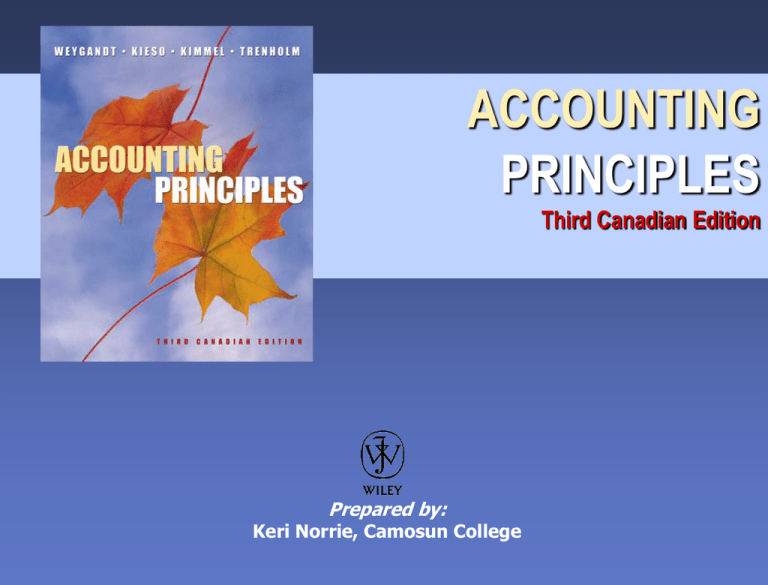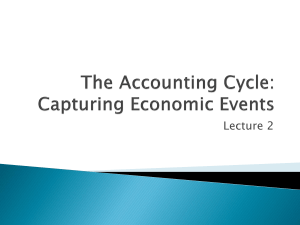
ACCOUNTING
PRINCIPLES
Third Canadian Edition
Prepared by:
Keri Norrie, Camosun College
CHAPTER 4
COMPLETION OF THE
ACCOUNTING CYCLE
WORK SHEET
A work sheet is a multiple-column form
that may be used in the adjustment
process and in preparing financial
statements.
It is a working tool or a supplementary
device for the accountant and not a
permanent accounting record.
Use of a work sheet should make
the preparation of adjusting entries
and financial statements easier.
WORK SHEET (Illustration 4-1)
Account Titles
Trial Balance
Debit
Credit
1. Prepare
trial balance
on the
worksheet.
Adjustments
Debit
Credit
2. Enter
adjustment
data.
Adjusted Trial Balance
Debit
Credit
3. Enter
adjusted
balances
Income Statement
Debit
Credit
Balance Sheet
Debit
Credit
4. Extend adjusted
balance to appropriate
columns.
5. Calculate income/loss
and complete the
worksheet.
PURPOSE OF CLOSING ENTRIES
1. Updates the owner’s capital account in
the ledger by transferring net income
(loss) and owner’s drawings to owner’s
capital.
2. Prepares the temporary accounts
(revenue, expense, drawings) for the
next period’s postings by reducing
their balances to zero.
TEMPORARY VERSUS PERMANENT
ACCOUNTS (Illustration 4-2)
TEMPORARY
These accounts are closed
PERMANENT
These accounts are not closed
All revenue accounts
All asset accounts
All expense accounts
All liability account
Owner’s drawings
account
Owner’s capital
account
DIAGRAM OF CLOSING PROCESS
Illustration 4-3
(INDIVIDUAL)
EXPENSES
Normal Dr.
Balance
-0-
(INDIVIDUAL)
REVENUES
Cr. to close
2
2. Debit the income
summary account for
total expenses, and credit
each expense account for
its balance.
Normal Cr.
Balance
-0-
Dr. to close
1
1. Debit each revenue
account for its balance,
and credit the income
summary account for
total revenues.
INCOME SUMMARY
Dr. Expenses
Dr. to close
Cr. Revenues
Cr. Balance = Net
Income
-0-
OWNER’S
CAPITAL
3
Opening Balance
Net Income
3. Credit the income
summary account for
the amount of net
income.
DIAGRAM OF CLOSING PROCESS
Illustration 4-3
OWNER’S
CAPITAL
Opening Balance
Net Income
Drawings
Ending Balance
4
4. Debit owner’s capital for the
balance in the owner’s drawings
account and credit owner’s
drawings for the same amount.
OWNER’S
DRAWINGS
Normal Dr.
Balance
-0-
Cr. to close
CLOSING ENTRIES
STOP AND CHECK
1. Does the balance in your
Owner’s Capital account
equal the ending capital
balance reported in the
Balance Sheet and
Statement of Owner’s
Equity?
2. Are all of your temporary
account balances zero?
POST-CLOSING TRIAL BALANCE
After all closing entries have been
journalized and posted, a post-closing
trial balance is prepared.
The purpose of this trial balance is to
prove the equality of the permanent
(balance sheet) account balances that
are carried forward into the next
accounting period.
POST-CLOSING TRIAL BALANCE
Illustration 4-5
Pioneer Advertising Agency
Post-Closing Trial Balance
October 31, 2005
The post-closing
trial balance is
prepared from the
permanent
accounts in the
ledger.
Cash
Accounts Receivable
Advertising Supplies
Prepaid Insurance
Office Equipment
Accumulated Amortization The post-closing
trial balance
Notes Payable
provides evidence
Accounts Payable
that the
Unearned Revenue
journalizing and
Salaries Payable
posting of closing
Interest Payable
entries has been
C.R. Byrd, Capital
properly
completed.
After Adjustment
Debit
Credit
$ 15,200
200
1,000
550
5,000
$
83
5,000
2,500
800
400
25
13,142
$ 21,950
$ 21,950
STEPS IN THE ACCOUNTING CYCLE
9. Prepare
post-closing
trial balance
1. Analyse
transactions
3. Post to ledger
accounts
8. Journalize
and post
closing entries
7. Prepare
financial
statements
2. Journalize the
transactions
4. Prepare a
trial balance
6. Prepare
adjusted trial
balance
5. Journalize
and post
adjusting
entries
REVERSING ENTRIES
(Optional Step)
A reversing entry is made at the
beginning of the next accounting period.
A reversing entry reverses certain
adjusting entries made in the previous
period. Opening balances can then be
ignored when preparing year-end
adjusting entries.
This topic is illustrated in Appendix 4B.
CORRECTING ENTRIES
Errors that occur in recording transactions
should be corrected as soon as they are
discovered by preparing correcting entries.
Correcting entries are unnecessary if the
records are free of errors; they can be
journalized and posted whenever an error is
discovered.
They involve any combination of balance
sheet and income statement accounts.
STANDARD BALANCE SHEET
CLASSIFICATIONS
Financial statements become more useful when
the elements are classified into significant
subgroups.
A classified balance sheet generally has the
following standard classifications:
Assets
Current Assets
Long-Term Investments
Property, Plant and
Equipment
Intangible Assets
Liabilities and Equities
Current Liabilities
Long-Term Liabilities
Owner’s/ Partners’/
Shareholders’ Equity
CURRENT ASSETS
Current assets are cash and other
resources that are reasonably expected
to be realized in cash or sold or
consumed in the business within one
year of the balance sheet date or the
company’s operating cycle, whichever
is longer.
Listed in the order of liquidity.
Examples of current assets are cash,
temporary investments, accounts
receivable, inventory, and prepaids.
LONG-TERM INVESTMENTS
Long-term investments are resources that
can be realized in cash, but the conversion
into cash is not expected within one year or
the operating cycle, whichever is longer.
Examples include investments in shares or
bonds of another company or investment in
land held for resale.
100
XYZ shares
PROPERTY, PLANT, AND EQUIPMENT
Property, plant, and equipment are long-lived
tangible resources that are used in the
business and not intended for sale.
Examples of property, plant, and equipment
include land, buildings, and machinery.
INTANGIBLE ASSETS
Intangible assets are noncurrent resources
that do not have physical substance.
Examples include patents, copyrights,
trademarks, or trade names that give the
holder exclusive right of use for
a specified period of time.
CURRENT LIABILITIES
Current liabilities are obligations that are
reasonably expected to be paid from
existing current assets or through the
creation of other current liabilities within
one year or the operating cycle, whichever
is longer.
Examples include accounts payable,
unearned revenue, interest payable, and
current maturities of long-term debt.
LONG-TERM LIABILITIES
Obligations expected to be paid after one
year are classified as long-term liabilities.
Examples include long-term notes
payable, bonds payable, mortgages
payable, and lease liabilities.
EQUITY
The content of the equity section varies with the
form of business organization.
In a proprietorship, there is a single owner’s
equity account called (Owner’s Name), Capital.
In a partnership, there are separate capital
accounts for each partner.
For a corporation, owners’ equity is called
shareholders’ equity, and it consists of two
accounts: Share Capital and Retained Earnings.
CLASSIFIED BALANCE SHEET IN
REPORT FORM (Illustration 4-14)
Pioneer Advertising Agency
Balance Sheet
October 31, 2005
Assets
Current Assets
Cash
Accounts Receivable
Advertising Supplies
Prepaid Insurance
Total Current Assets
Capital Assets
Office Equipment
Less: Accumulated Amortization
Total Assets
$
$
5,000
83
$
15,200
200
1,000
550
16,950
4,917
21,867
Liabilities and Owner's Equity
Current Liabilities
Notes Payable
Accounts Payable
Unearned Revenue
Salaries Payable
Interest Payable
Total Current Liabilities
Long-term Liabilties
Notes Payable
Total Liabilities
Owner's Equity
C.R. Byrd, Capital
Total Liabilities and Owner's Equity
$
1,000
2,500
800
400
25
4,725
4,000
8,725
$
13,142
21,867
A classified balance sheet
helps the financial
statement user determine:
• The availability of
assets to meet debts as
they come due, and
• The claims of short- and
long-term creditors on
total assets.
The balance sheet is most
often presented in the
report form, with the assets
shown above the liabilities
and owner’s equity.
LIQUIDITY
Liquidity measures ability to pay shortterm obligations when they come due.
Working capital is one important
measure of liquidity.
WORKING CAPITAL = CURRENT ASSETS - CURRENT LIABILITIES
CURRENT RATIO
The current ratio (working capital ratio) is a
widely used measure for evaluating a
company’s liquidity and short-term debtpaying ability. It is calculated by dividing
current assets by current liabilities and is a
more dependable indicator of liquidity than
working capital.
CURRENT ASSETS
CURRENT RATIO = ———————————
CURRENT LIABILITIES
COPYRIGHT
Copyright © 2004 John Wiley & Sons Canada, Ltd. All rights
reserved. Reproduction or translation of this work beyond that
permitted by Access Copyright (The Canadian Copyright
Licensing Agency) is unlawful. Requests for further information
should be addressed to the Permissions Department, John Wiley
& Sons Canada, Ltd. The purchaser may make back-up copies for
his or her own use only and not for distribution or resale. The
author and the publisher assume no responsibility for errors,
omissions, or damages caused by the use of these programs or
from the use of the information contained herein.




